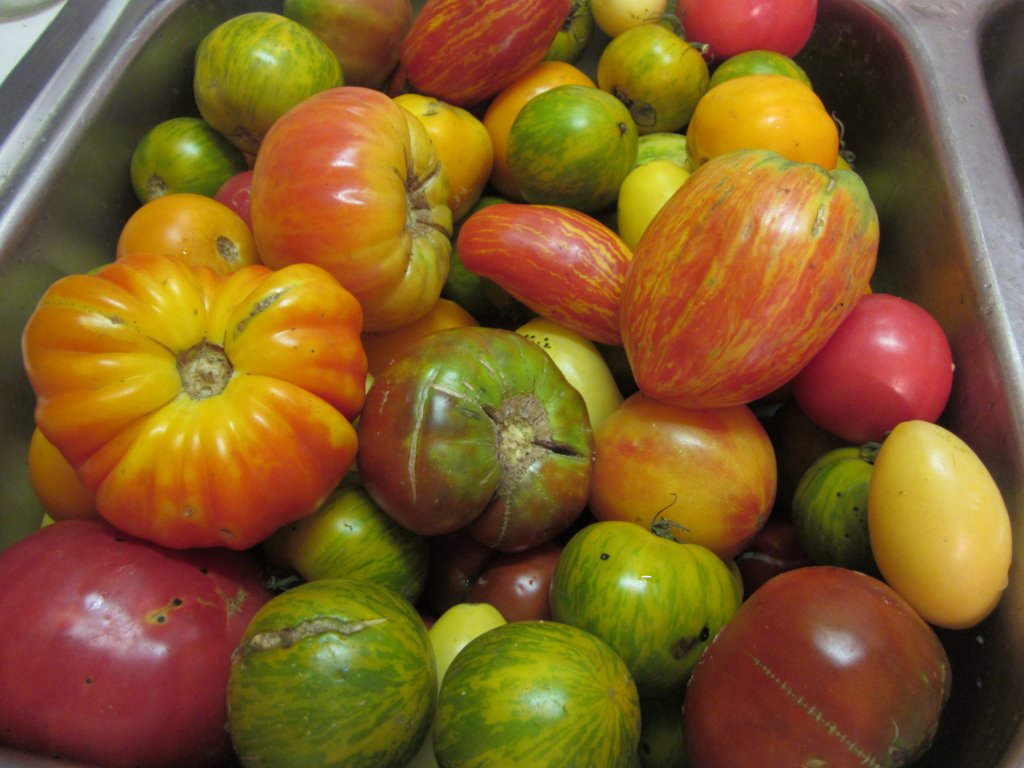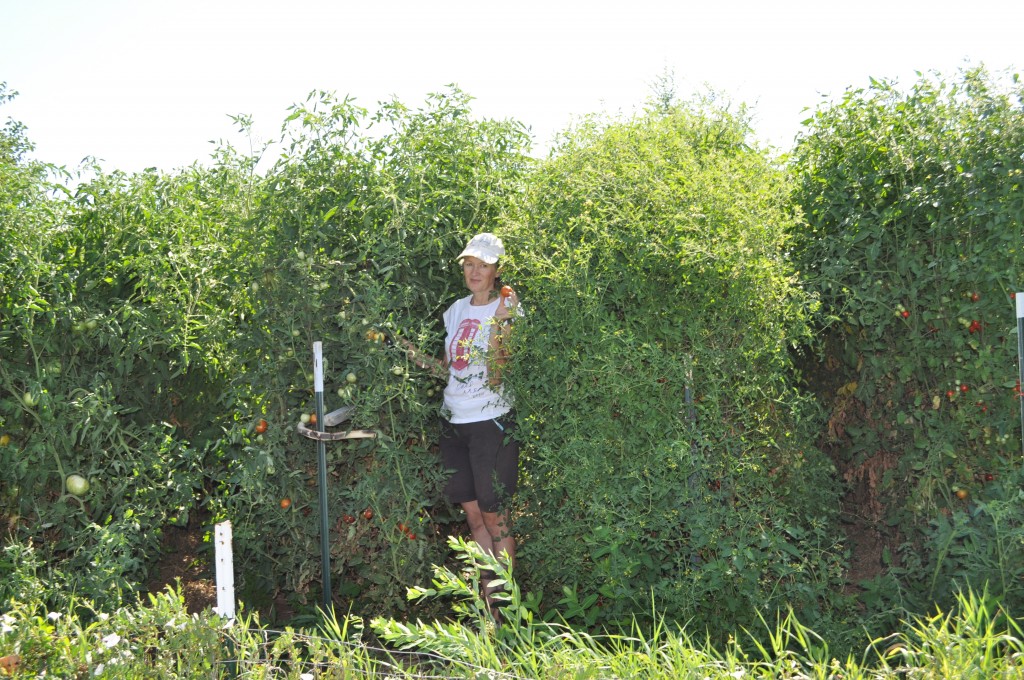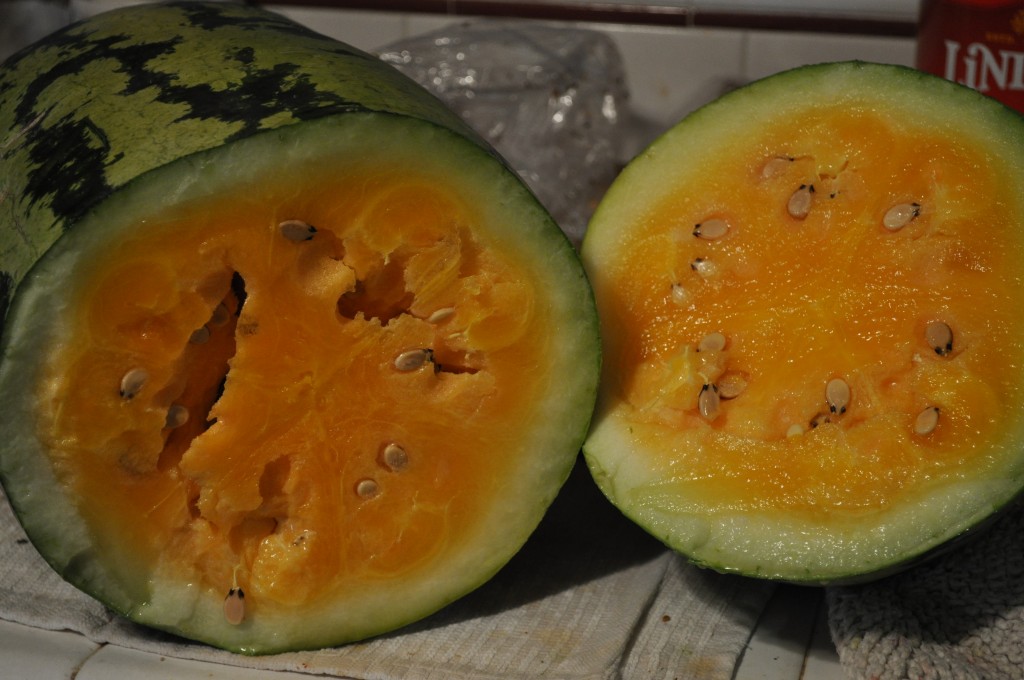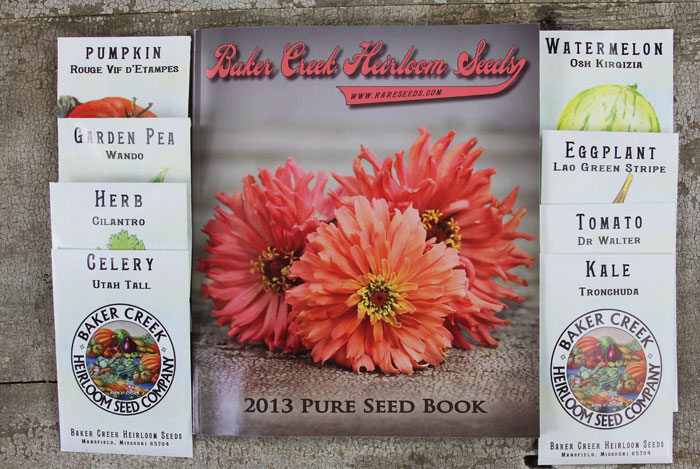Heirlooms, GMOs, Open-Pollinated, Hybrids . . . which do I choose?
It is garden-planning and seed-choosing time again! This is a dilemma: the seed catalogs start coming in November (earlier and earlier every year, it seems) and I’m garden-hungry by December. I start dog-earring my catalogs and making intricate garden plans and lists of new things I want to try, in early January. By February, I’m tired of buying shiny, tasteless, expensive vegetables at the grocery store, and my seed list has grown as long as my arm.
Also. In February I’m ignoring notes that I have written to myself that say “Do Not Plant So Much Next Year.” I am totally ignoring these notes! I’m just scribbling away on my seed order, in a demented fog of longing. I am longing, Gentle Readers, for the feel of loamy soil between my fingers. I’m longing for that pungent smell that a tomato leaf has when you pinch it. I’m yearning to once again have rows of basil, kale, Swiss chard, and herbs that I can bring in from the garden every afternoon to build a meal around, not to mention crunchy radishes and carrots to pull. I’m longing for handfuls of sweet heirloom cherry tomatoes to gorge on on a hot day, and of course a big ole’ juicy Brandywine tomato to slice up on my BLT.
My mouth is watering here, no kidding!
Winter has its charms. Cold and snow have their usefulness, and I love to go sledding with the kids and of course I just enjoy looking at at the snowy landscape. I think snowmen with carrot noses are particularly picturesque. I do. I’m glad that it gets cold enough in Nebraska to freeze all the bugs.
But I start living, really living, in Spring. I was made to grow things, I think. Growing things, for me, is my raison d’etre, as the French say. My reason for existence. (I’m not completely serious here, but my longing for spring does seem to exaggerate this feeling.) Well, okay, as a Christian (from the Shorter Catechism) my raison d’etre is to glorify God, and to enjoy Him forever. I simply prefer to do this outside, in my garden, preferably.

I never tire of the variety of the heirloom tomatoes that I grow!
I’ve noticed at my farmer’s market table, as I chat with my garden veggie-loving friends, that few people really understand the difference between the terms “heirloom,” “open-pollinated,” and “hybrid,” even if they are gardeners themselves. I sell heirloom tomatoes from my garden. People ask all the time what “Heirloom” means.
Also, although here in the Midwest we are surrounded by amazing fields of GMO crops–mainly corn and soybeans–few people really understand the term “GMO,” or how these crops affect us adversely.
Maybe we’re just all so busy doing our jobs and raising our kids and keeping our lawns mowed and feeding our red wiggler worms in the basement and keeping up with the news and the latest movies that we just don’t have time to do something like learn about what we are stuffing into our mouths every day. I can understand this. There was a time when I was too busy raising small children, some days, to do anything more than just open a box of macaroni and cheese and make it for lunch. And be thankful for it. (Well, sometimes I’d get fancy and throw a can of tuna and a bag of frozen peas in it.)
But this strikes me as a bit short-sighted, not only for our health and well-being, but for our future food supply. How is it that we know the latest gossip about the celebrities we are interested in, yet have no idea how most of the food that we eat every day is produced, or even what it might be doing to our bodies?
This is a mighty complicated issue, and all I can offer today is a quick primer on seeds for you. If you’re interested in learning more, there are scads of terrific websites where you can learn more, and several excellent books, as well.

This is me, in my jungle of tomato plants. All these plants were raised from heirloom seeds that I saved myself. Don’t be impressed: saving seeds is a very easy, quick process.
I hope by doing so that I’ll pique your interest in your food choices, and help you make better ones! Maybe I’ll even convince you to grow a small garden for yourself, and you’ll be the happier, and the better for it–not to mention more popular! Much of this information I learned from one of my favorite seed catalogs, “Bountiful Gardens.” You can request this catalog right here, and learn a bunch while you’re at it! Like what a mangle is. Or how to grow a sugar beet! Ready? Okay, here we go!
TRADITIONAL PLANT BREEDING: A flower from one plant is pollinated with pollen from a related plant–perhaps a plant with preferable attributes. This is done over several generations, and plants are selected for desirable traits. For example, spinach becomes different from the tough wild plants that were its ancestors.
OPEN-POLLINATED: People keep saving seeds from their best plants, and the resulting plants become more predictable. Eventually the seed is “stabilized” and you can count on getting the same kind of broccoli, for instance, when you plant your broccoli seed. You can save these seeds yourself from year to year.
HEIRLOOM: These seeds are open-pollinated types that have been around awhile (at least 50 years) and so are stable and predictable. Many people use the term “heirloom” loosely to refer to anything open-pollinated, new or old, so ask for clarification if you suspect this and are looking for the old varieties. These older varieties are often more nutritious and more adapted to organic growing–since that used to be all there was. The open-pollinated varieties that farmers and growers are working on right now will be the heirloom varieties for future gardeners.

This watermelon I grew from heirloom seeds from Baker Creek Heirloom Seeds and it was one of the tastiest watermelons I’ve ever eaten. It’s called “Orange-Glo.”
HYBRID SEEDS: Seeds from the first generation of a cross between two varieties. Plants are very uniform and predictable, which is why farmers like to use them. You can not save the seeds, as the next generation of plants won’t be predictable. The negative thing about hybrids is not how they were made; it’s that their parentage is secret and you can’t save seeds and get predictable results form them. Hybrids make gardeners dependent on the companies who produce the seed. Most big-box or hardware-stores primarily carry only plants and seeds that are hybrids.
There are many who believe that food crops should be a common heritage that we share, and not a set of commercially-driven trade secrets. I happen to agree with this opinion. Not to sound alarmist, but in the case of a collapse of the economy, (God forbid!) or other such disaster, our being able to feed our families may depend on whether we can obtain seeds or not. The best seeds for our gardens, of course, would be seeds that have been saved over years and that are from plants that have adapted to local growing conditions. Here in Nebraska that would mean hot, dry, windy summer conditions!
You still with me? Right. We’re almost done. Hang in there! Here’s where it gets interesting and a little scary. But don’t give up. You ought to know this stuff, if you don’t already.
GMO VARIETIES: These are not the result of traditional plant breeding, but of procedures in a laboratory. Instead of using pollen from another plant, technicians can insert genes that don’t even come from plants. They might come from a bacteria or a fish! Viruses are often used to insert the gene that is wanted. GMO seeds are sold mostly to big agribusiness farms who sign a contract with the GMO company: mostly corn, soy, peanuts, and canola are grown from these seeds. The crops are used for animal feed and processed foods that go to supermarkets (think high fructose corn syrup). The danger to home gardens is from the pollen in the air and food at the store. Many suspect that our honeybee problems (and there are many, believe me: we keep bees and it’s a real struggle to keep them alive every year) in this country are wrapped up in the presence of GMO pollen. There are many other concerns, too, though I can’t go into them all here.) Many, many seed catalogs now carry seeds from the big companies that also product GMO seed.
When I started growing my garden from heirloom seeds many years ago, I was told to put in a few hybrid plants, because the heirloom plants supposedly are more prone to disease. I’ve not found this to be true, and in fact grow all my plants now from heirloom seeds. Look at the picture above of me standing amidst my tomato patch last year to see how healthy and lush my tomato plants were, and they were all grown from heirloom seeds!
Growing heirlooms will afford you the biggest variety, and you’ll know that you’re growing the old varieties that were not altered for commercial uses. Most of the tomatoes and melons and peppers and what-not that you buy in the supermarket (or even the farmer’s market, if your grower doesn’t grow heirloom seeds!) are grown from hybrid plants that have been altered to make the fruit more commercially viable: tomatoes, for instance, have a tougher skin and have a greater shelf life. Cucumbers are bred to be more uniform. And so on.
That’s why the older folks at our farmer’s market will come to me to buy heirloom tomatoes, to get that “old-fashioned tomato taste.” My heirloom tomatoes wouldn’t put up with being stored for more than a few days, and they certainly wouldn’t hold up to being shipped across the country, but they taste the best. And if you’re buying vegetables for your family, isn’t that the most important thing?
I hope this primer has been helpful to you. There are many, many resources on the internet for you if you want to learn more about this issue. Many garden centers do carry a few heirloom plants now, especially tomatoes, and you can look for them if you want to try out heirlooms. Or there are a number of exceptional catalogs available, and they’ll sell you heirloom seed and other gardening aids, too, and you’ll learn a lot, too.
Here is one of my favorites, which you can request at http://rareseeds.com/requestcatalog. You really ought to get this catalog just to see the astonishing variety of heirloom seeds that are available to growers. I really appreciate the Baker Creek folks and others who have made it their mission to save and preserve all these old varieties! There are glossy photos of hundreds of varieties of tomatoes in all colors, melons in all shapes and sizes, and many squashes and peppers, too! Beware–it’s very tempting to order more seeds that you can actually grow, if you get this catalog! (Guilty!)

- This catalog is just beautiful and so much fun to read! (Image from http://rareseeds.com/requestcatalog
You really ought to get this one, too:

The image above was borrowed from http://www.bountifulgardens.org/, and you could request a catalog from that site. I’ve learned a great deal from this catalog, like what fodder radishes are, and how to grow my own quinoa, and what a mangel is and why I should care. They also have an impressive list of books for sale on topics like saving your own seed, and how to garden more sustainably.
There are other sources to buy heirloom seeds from, too, of course, if you do an online search. Good luck to you in your garden planning, and happy growing this year!
- Need to lift some spirits? Make Butter-Dips!
- Chasing horses on your feet will get you absolutely nowhere


I love gardening, I do! Never happier than when my head is in a seed catalogue!
I’d like to see a poem, Caro, about this “February longing.”
Wow, I had no idea seeds had this much to them. 🙂 Thanks for sharing.
Fascinating, huh, Erin? And I just touched the tip of the iceberg.
What a great primer on seeds! Learned a lot and sharing!
Thanks so much for your comment and for sharing, Alessa. You are my BFF. 😉
Wow, now I’m ready to get a little dirt under my fingernails. Thanks for the address information. I sometimes talk about our place in Mexico, but actually we have three. Two are small pieces of farmland, just big enough to feed some food for of our large family group. I need seeds like these because some seeds are hard to find down there. I would like to invite you to visit: Ocean Robbins ([email protected]) for more information about GMO’s which I know you are well aware of already. This is just up to date information, where I find out things like the fact that they are trying to start raising GMO salmon etc. We are already planning what we will be raising here in Wisconsin this spring and summer. Love those tomatoes.
Thanks, Chef, I am now a member of The Food Revolution! Very cool! What kinds of things do you grow in Mexico, compared to what you grow in Wisconsin? Much longer growing season there, I know! The great thing about heirlooms is, with some care, you can save seed from year to year. There are many stories included with many seeds, too–who saved them through the years. Thanks for your comments!
Catching the fever !!
Oh, me too, Janelle, I’ve been sick with it for some time now!
Thanks for providing the definitions of the different kinds of seeds. Will have to see if the resources you provided ship to Canada! Can’t wait to get up to the garden this year and put more into our food growing garden. Thanks again. Wendy
Wendy,
I would imagine they would ship to Canada–I hope so! Best wishes on your gardening efforts this year!
Wonderful and informative blog! Can’t wait to buy some seeds. Love the tomato plants! Sharing your blog!
Tami,
You are TOO GOOD TO ME! Thanks so much for sharing. Best wishes on your gardening this year!!
Cant wait – got my veg plot all ready and compost doing well. Extra excited this year with new home/new garden – looking forward to seeing what shows up. Making bird table and gate arch from fallen branches – awww could crush a grape LOL
Don’t you love new beginnings, Cher? I do! Composting is fun, isn’t it, and gardening even more fun! Thanks again for reading!
Amy Amy Amy, I am so excited about getting in our garden to grow herbs and and vegetables. What have you done to me, I am on countdown till I can get my worm farm too 🙂
Lovely looking veggies and nice post. I’m glad we have a farmers market in New York City. It’s year round, so we get a lot of great, fresh veggies~
I can’t imagine being able to choose from a farmer’s market all year long. Where is the food grown, though, during the winter?
I totally want to try some orange watermelon!
Oh, you really, really ought to! So delicious!